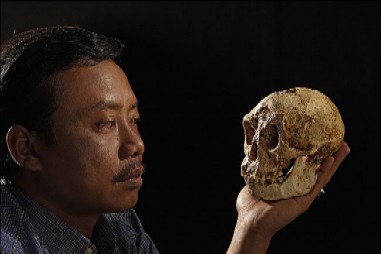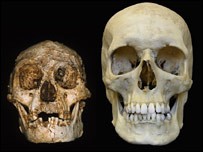Were Hobbits Relict Homo erectus?
Posted by: Loren Coleman on September 5th, 2008

According to a new analysis of the skull of Homo floresiensis, it appears that the Hobbits might have been a group of small Homo erectus, relict, in terms of surviving and evolved, not “primitive.”
There is a new paper by G. A. Lyras, M. D. Dermitzakis, A. A. E. Van Der Geer, S. B. Van Der Geer, and J. De Vos, entitled “The origin of Homo floresiensis and its relation to evolutionary processes under isolation,” in Anthropological Science, from The Anthropological Society of Nippon, 2008.
“Abstract: Since its first description in 2004, Homo floresiensis has been attributed to a species of its own, a descendant of H. erectus or another early hominid, a pathological form of H. sapiens, or a dwarfed H. sapiens related to the Neolithic inhabitants of Flores. In this contribution, we apply a geometric morphometric analysis to the skull of H. floresiensis (LB1) and compare it with skulls of normal H. sapiens, insular H. sapiens (Minatogawa Man and Neolithic skulls from Flores), pathological H. sapiens (microcephalics), Asian H. erectus (Sangiran 17), H. habilis (KNM ER 1813), and Australopithecus africanus (Sts 5).
“Our analysis includes specimens that were highlighted by other authors to prove their conclusions. The geometric morphometric analysis separates H. floresiensis from all H. sapiens, including the pathological and insular forms. It is not possible to separate H. floresiensis from H. erectus. Australopithecus falls separately from all other skulls. The Neolithic skulls from Flores fall within the range of modern humans and are not related to LB1. The microcephalic skulls fall within the range of modern humans, as well as the skulls of the Neolithic small people of Flores.
“The cranial shape of H. floresiensis is close to that of H. erectus and not to that of any H. sapiens. Apart from cranial shape, some features of H. floresiensis are not unique but are shared with other insular taxa, such as the relatively large teeth (shared with Early Neolithic humans of Sardinia), and changed limb proportions (shared with Minatogawa Man).”

The articles bottomline is clear: “On the grounds of this morphological similarity we agree with the phylogenetic schemes that suggest a close relationship between the Flores hominin and H. erectus.”
The pdf can be found here.
About Loren Coleman
Loren Coleman is one of the world’s leading cryptozoologists, some say “the” leading living cryptozoologist. Certainly, he is acknowledged as the current living American researcher and writer who has most popularized cryptozoology in the late 20th and early 21st centuries.
Starting his fieldwork and investigations in 1960, after traveling and trekking extensively in pursuit of cryptozoological mysteries, Coleman began writing to share his experiences in 1969. An honorary member of Ivan T. Sanderson’s Society for the Investigation of the Unexplained in the 1970s, Coleman has been bestowed with similar honorary memberships of the North Idaho College Cryptozoology Club in 1983, and in subsequent years, that of the British Columbia Scientific Cryptozoology Club, CryptoSafari International, and other international organizations. He was also a Life Member and Benefactor of the International Society of Cryptozoology (now-defunct).
Loren Coleman’s daily blog, as a member of the Cryptomundo Team, served as an ongoing avenue of communication for the ever-growing body of cryptozoo news from 2005 through 2013. He returned as an infrequent contributor beginning Halloween week of 2015.
Coleman is the founder in 2003, and current director of the International Cryptozoology Museum in Portland, Maine.









